Neoplasms of the Nose and Paranasal Sinuses Kevin

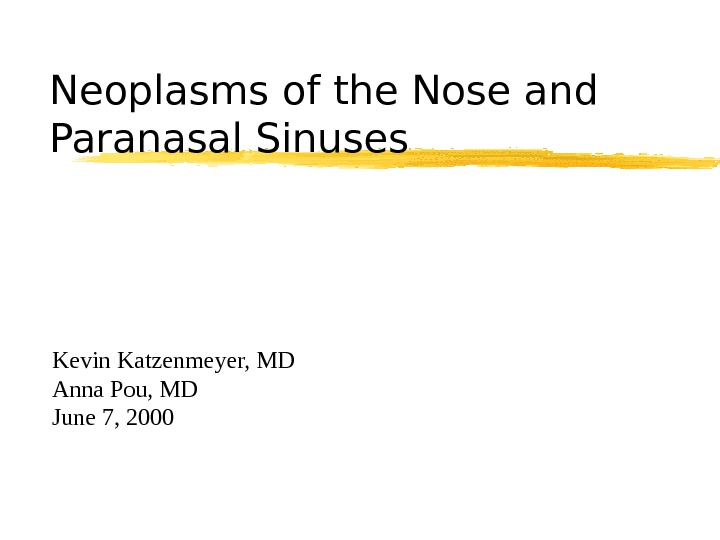
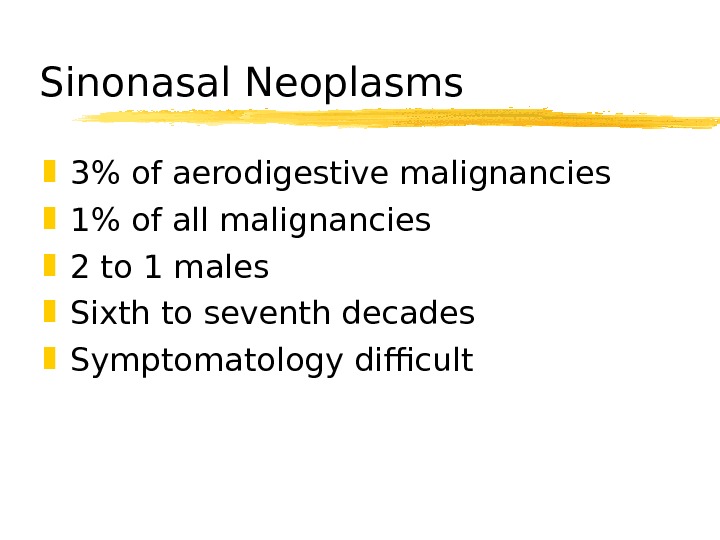
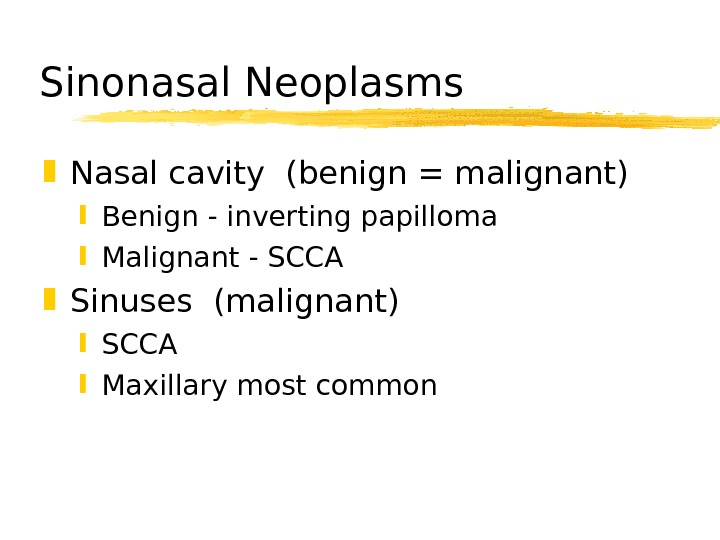
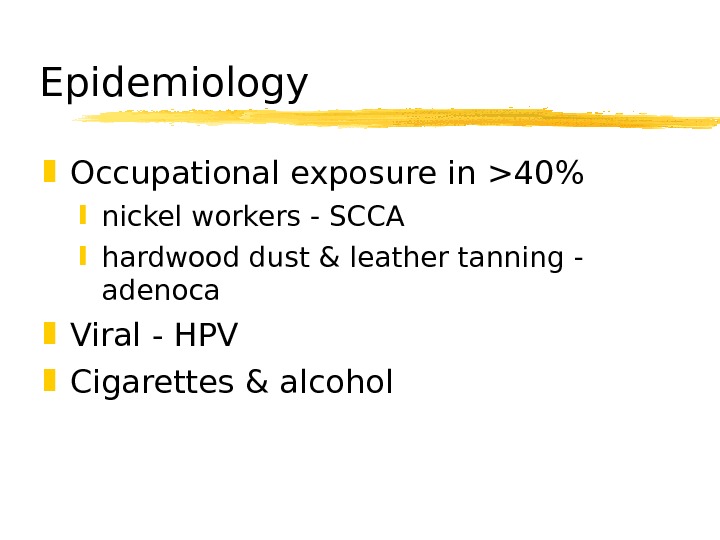
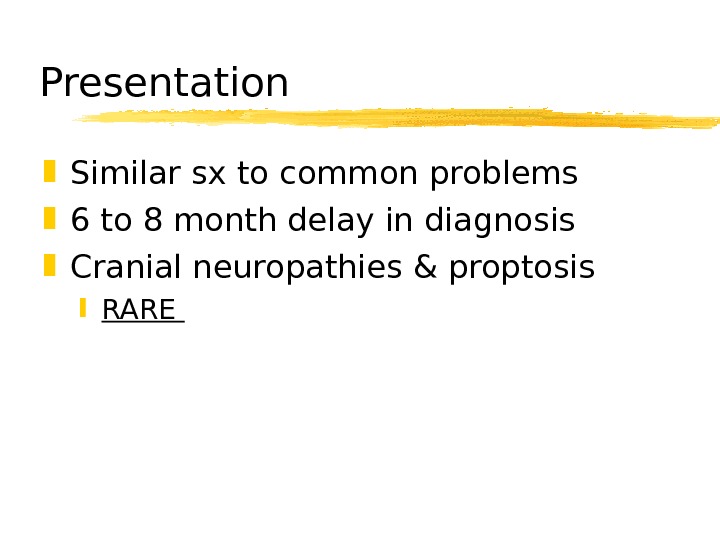
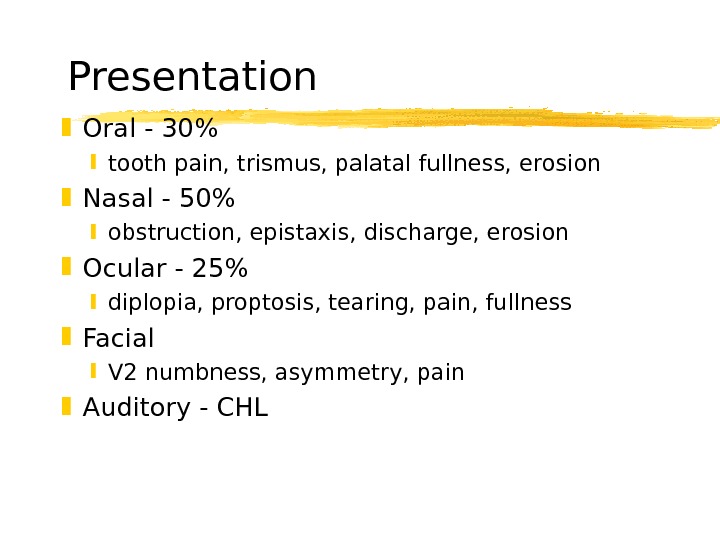
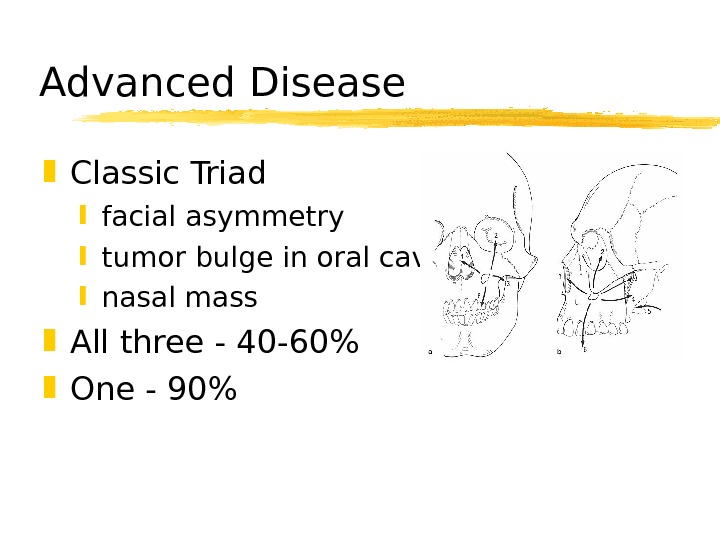
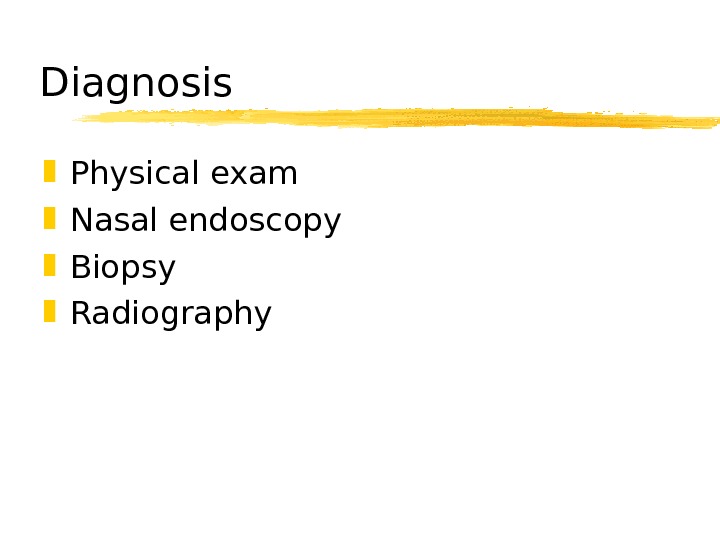
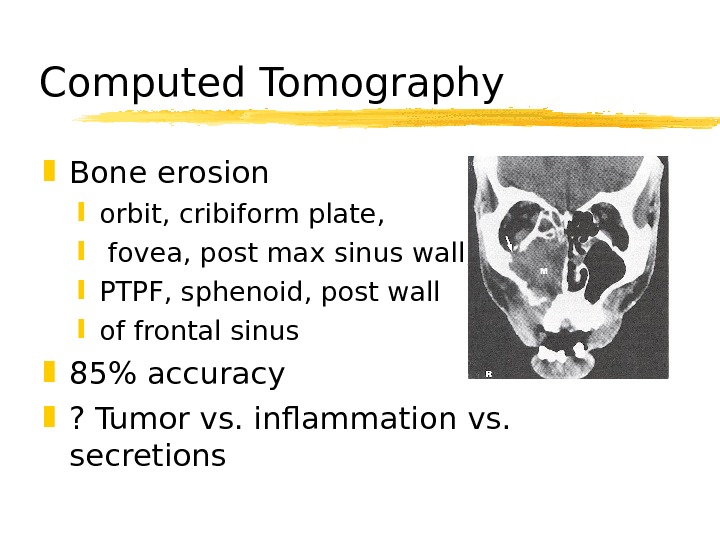
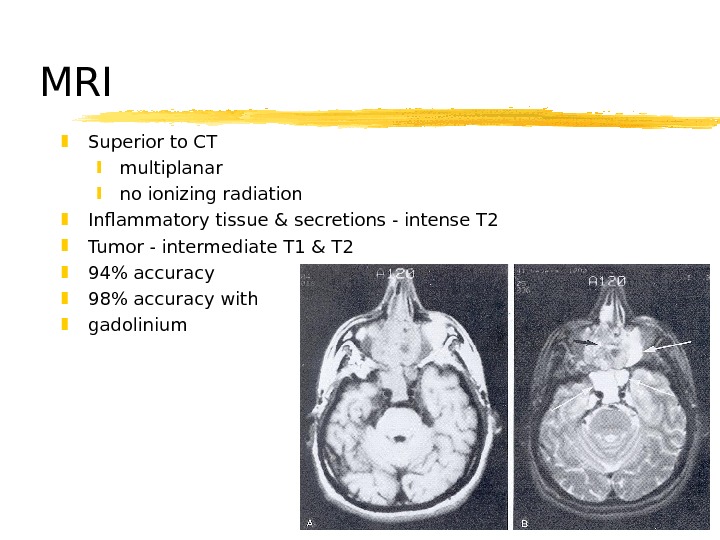
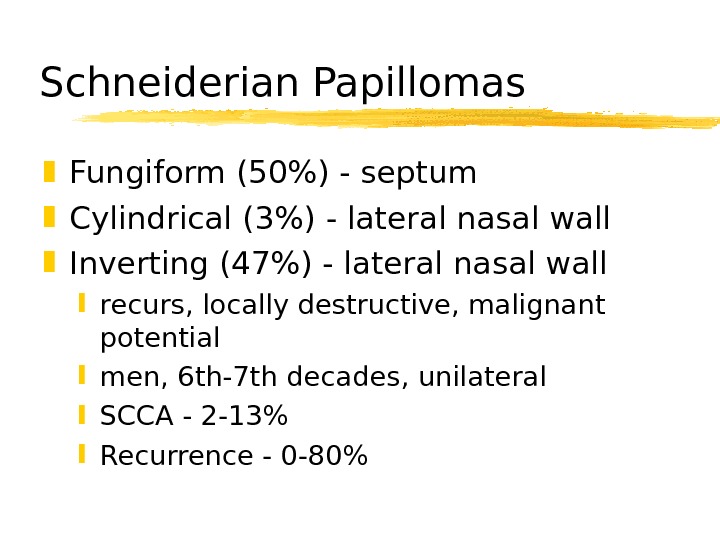
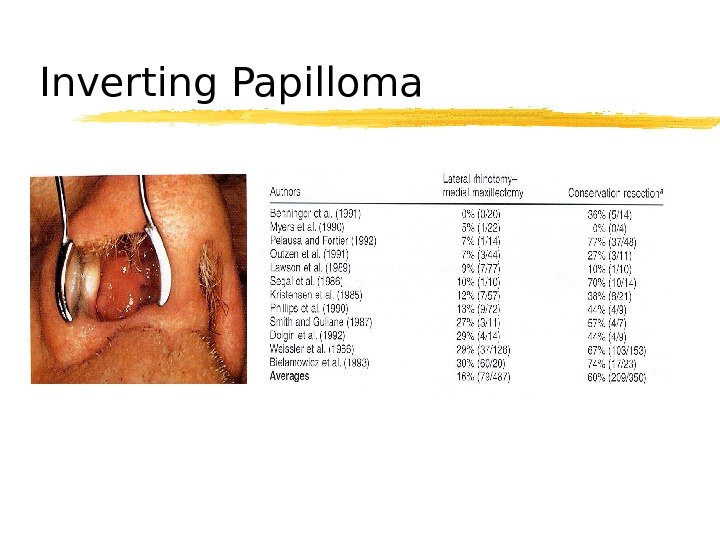
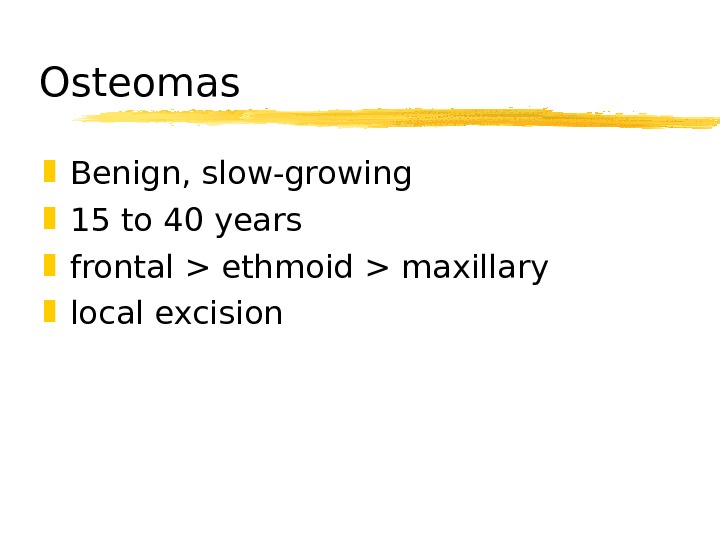
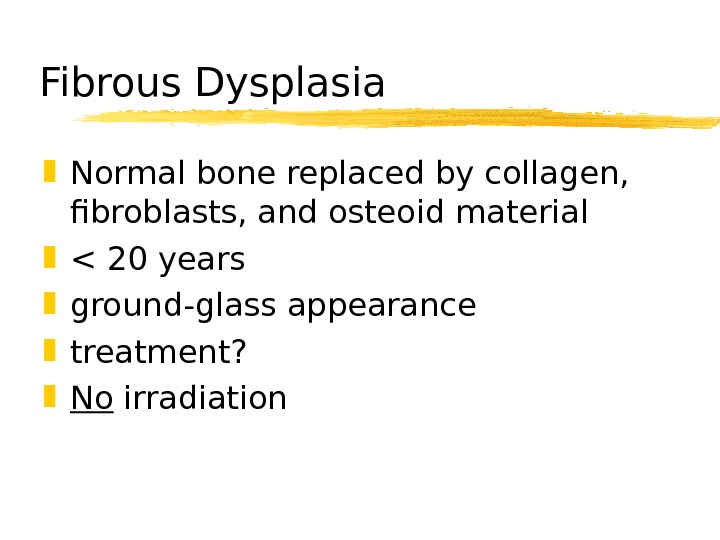
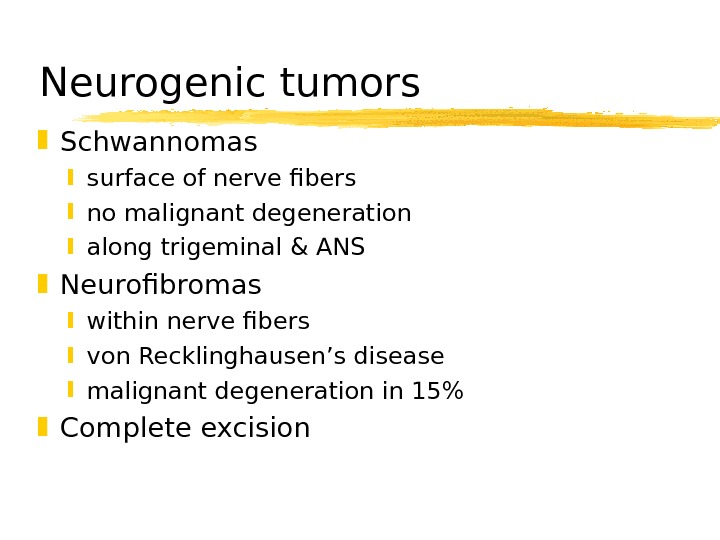
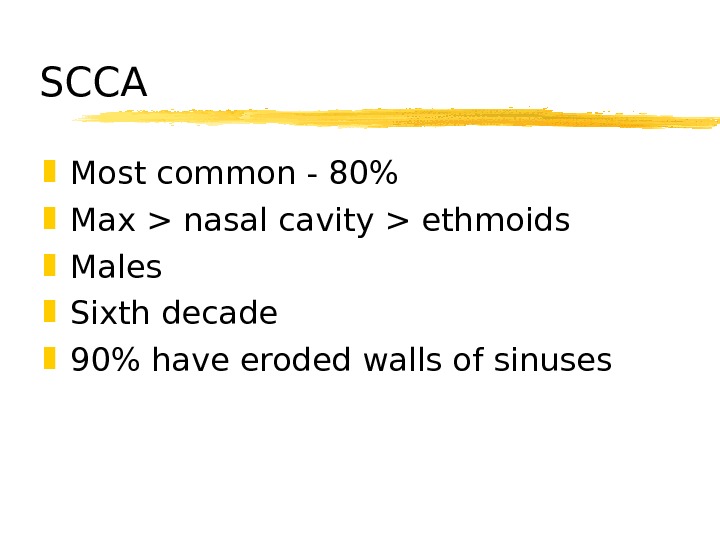
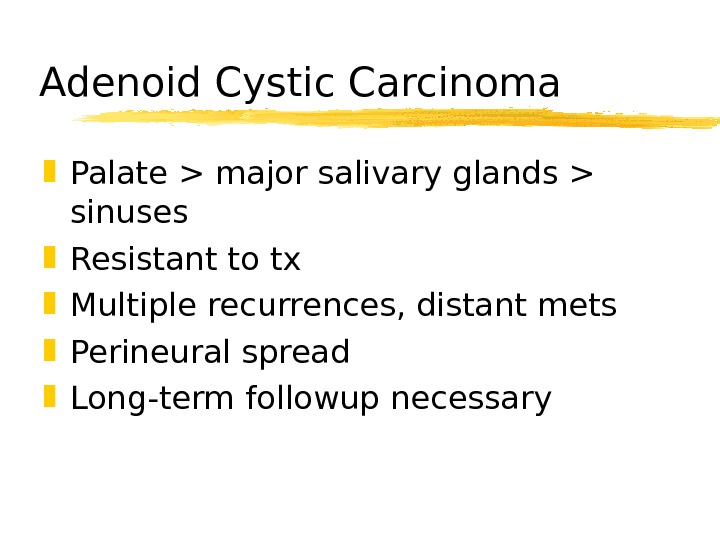
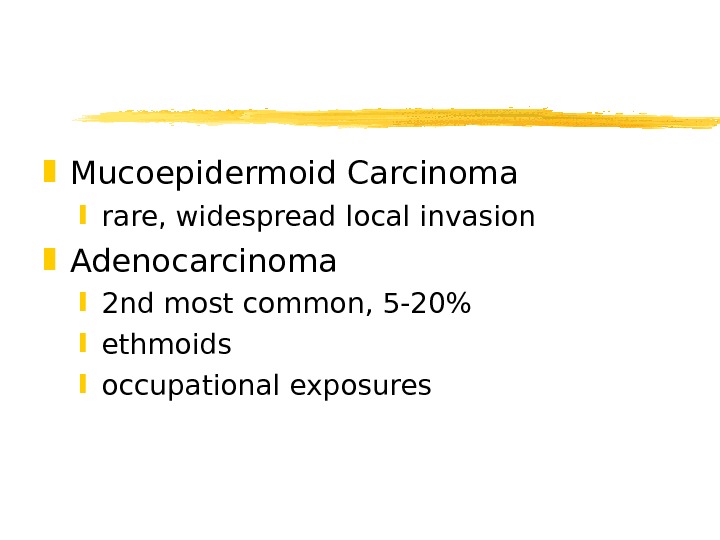
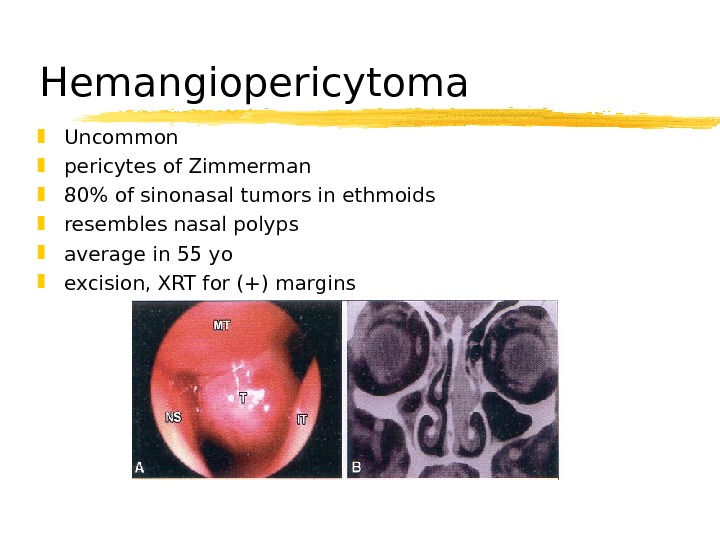
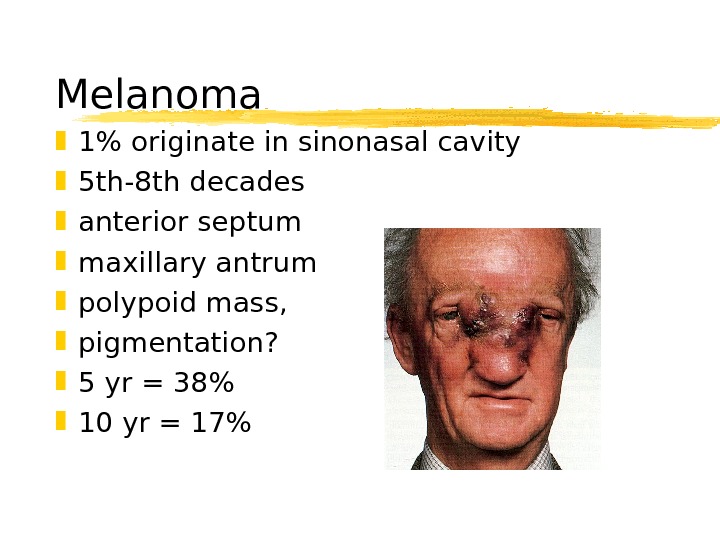
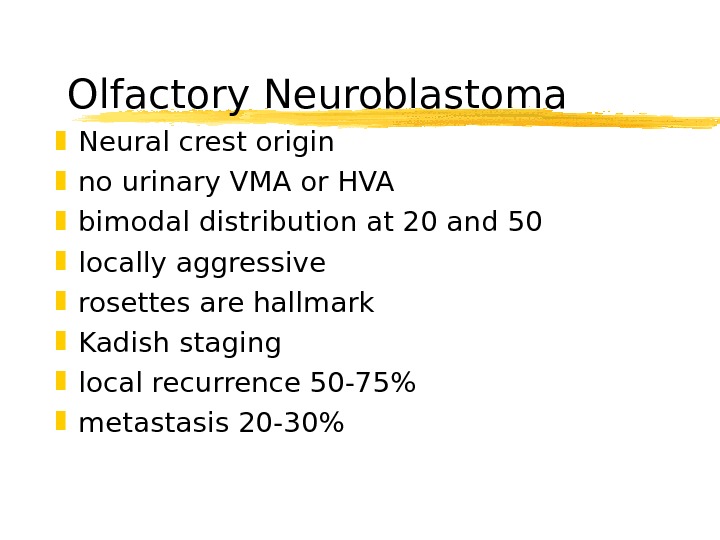
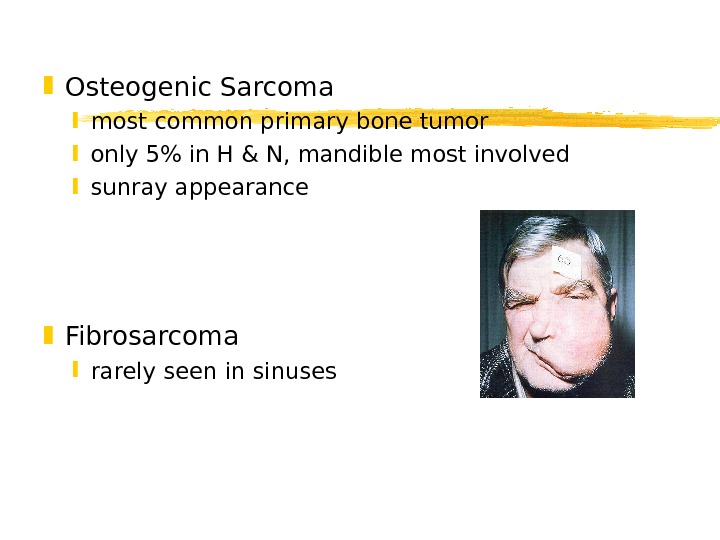
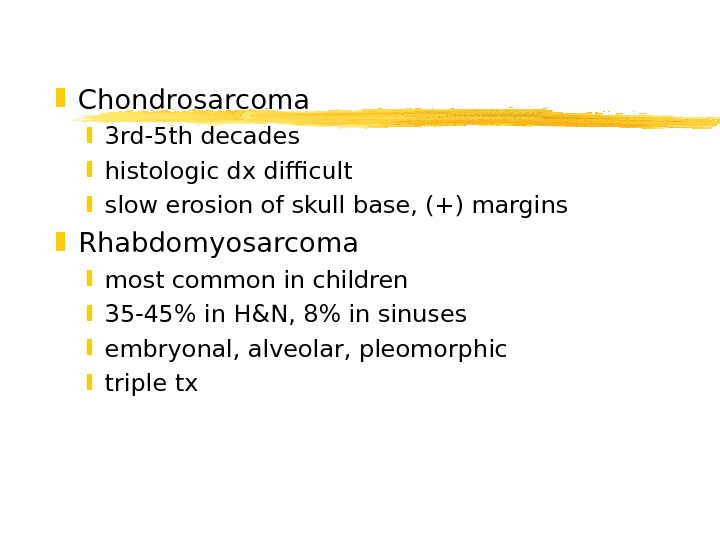
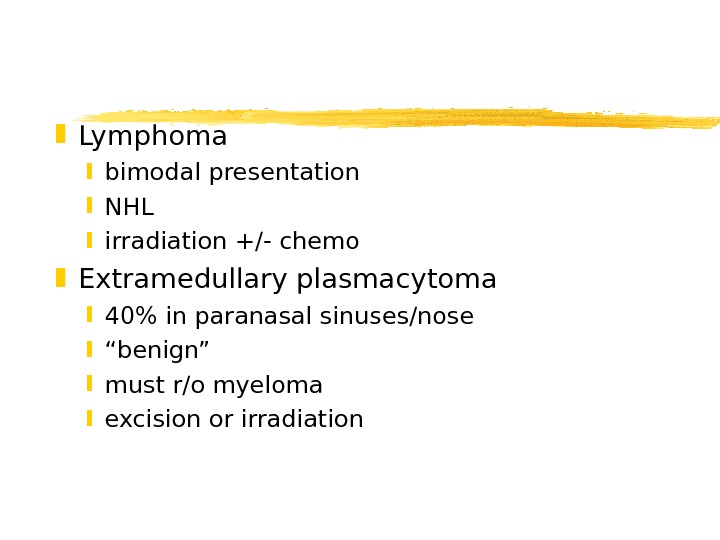
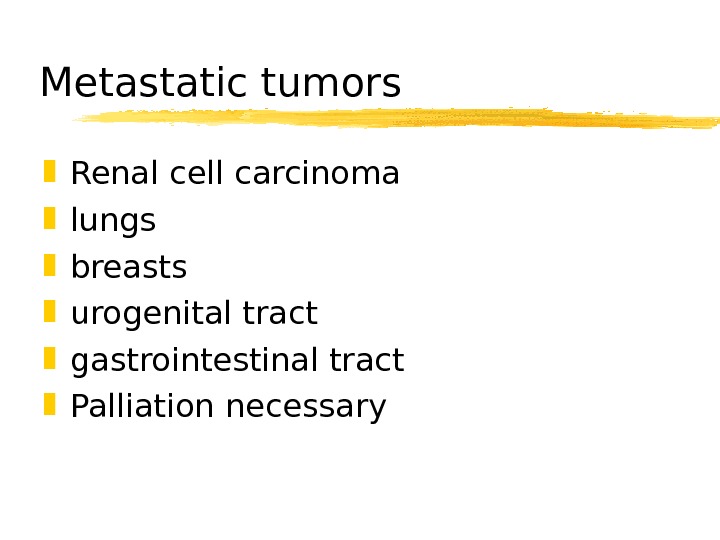
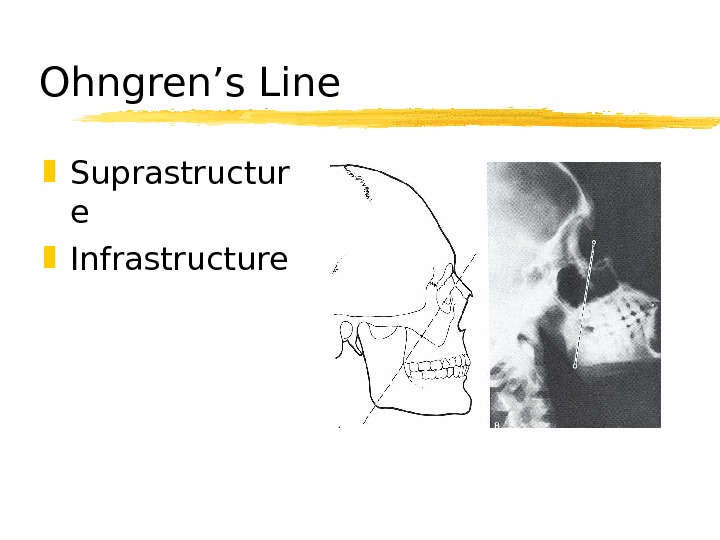
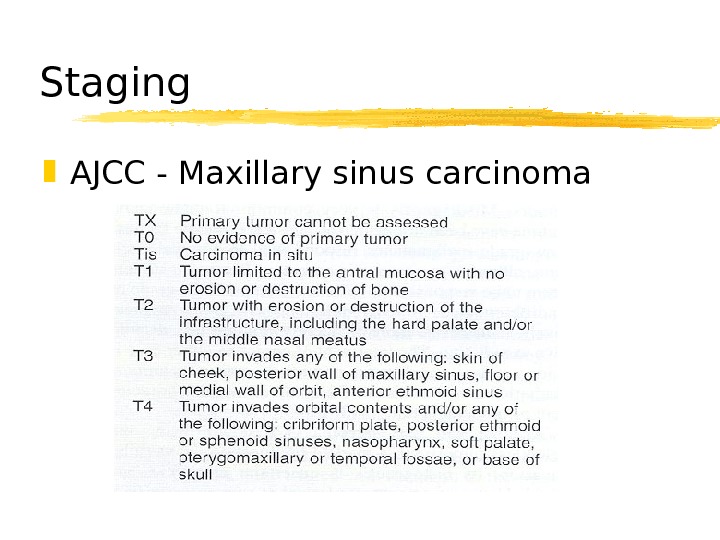
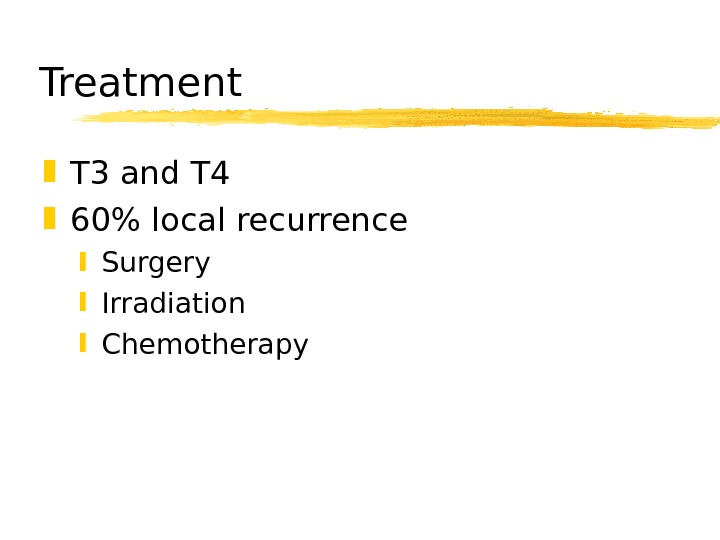
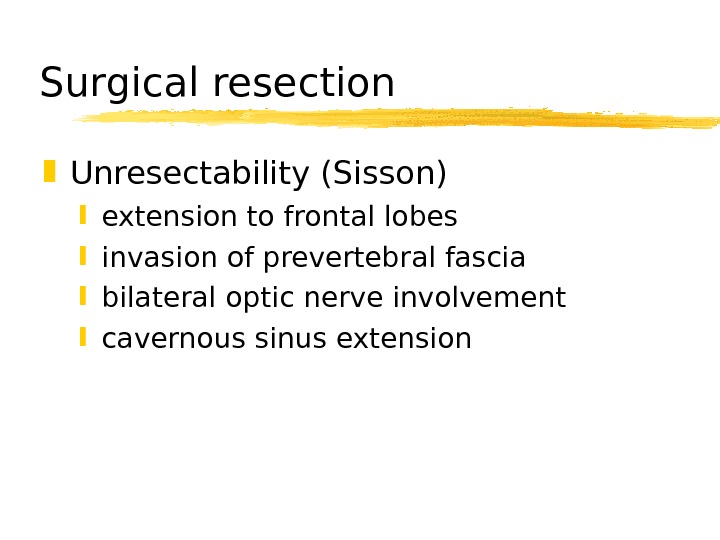
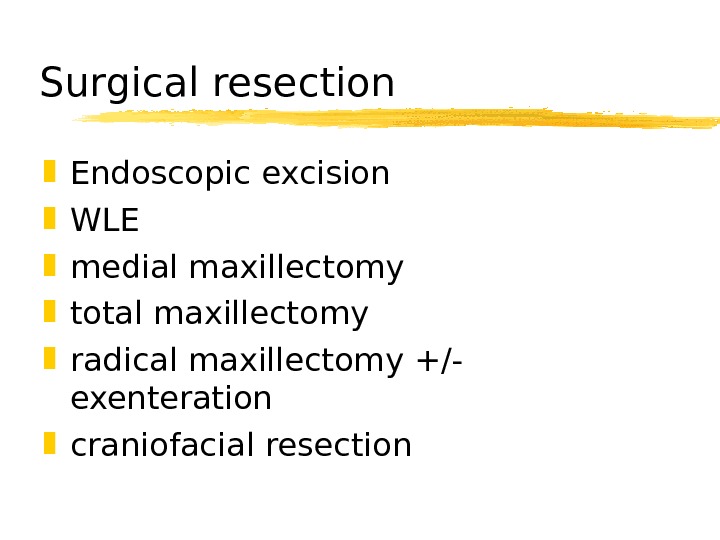
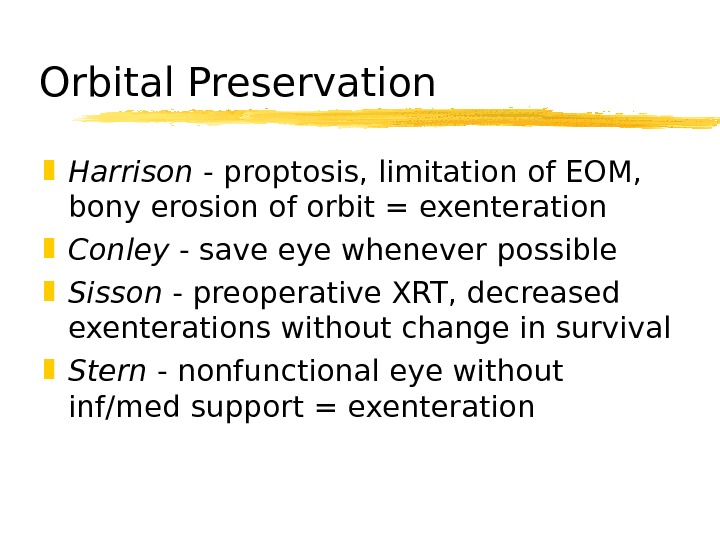
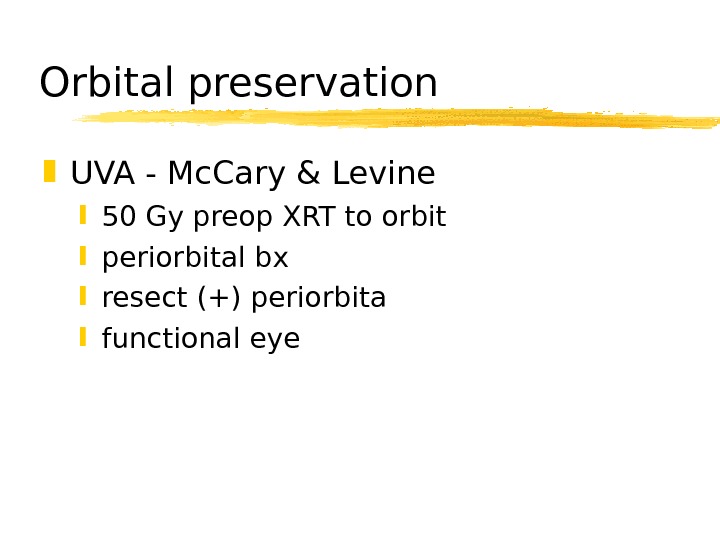
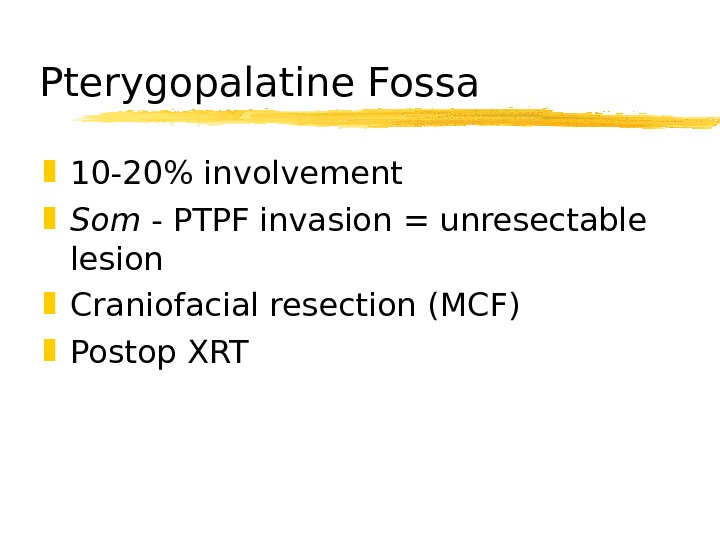
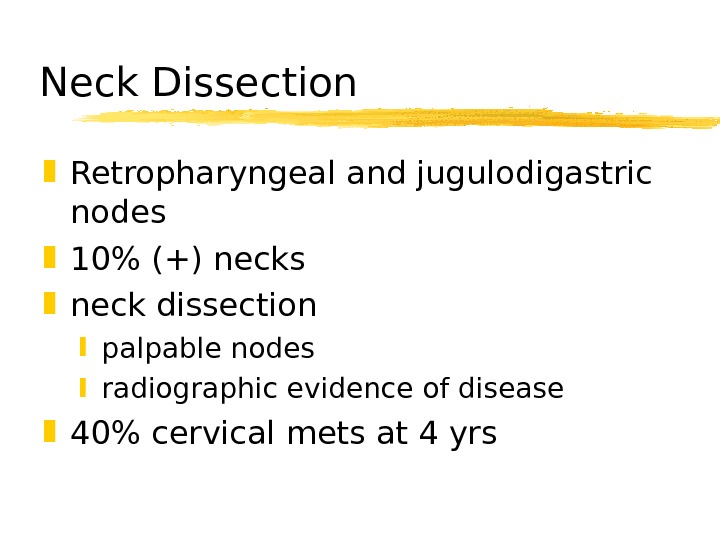
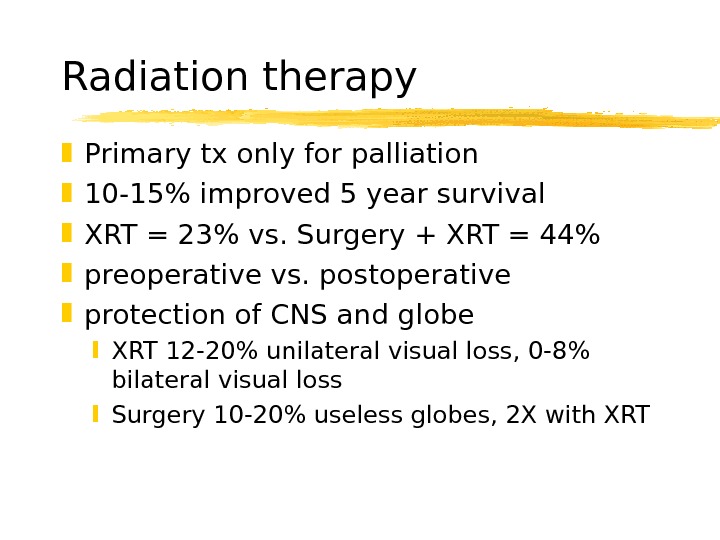
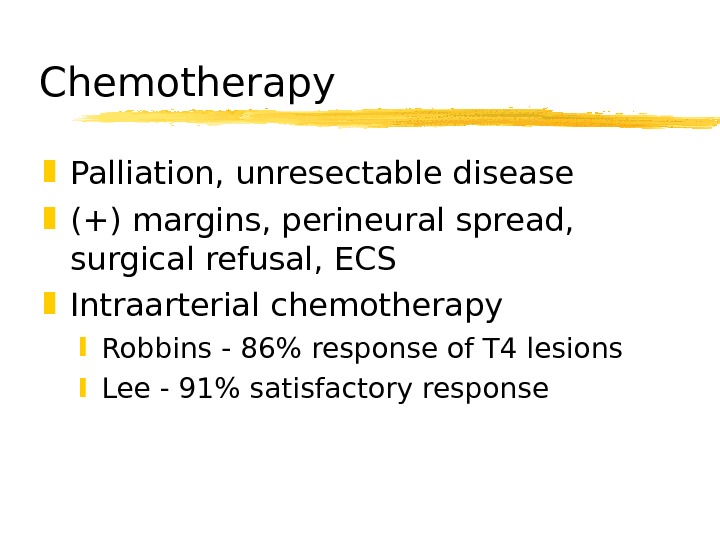
- Размер: 746.5 Кб
- Количество слайдов: 36
Описание презентации Neoplasms of the Nose and Paranasal Sinuses Kevin по слайдам
 Neoplasms of the Nose and Paranasal Sinuses Kevin Katzenmeyer, MD Anna Pou, MD June 7,
Neoplasms of the Nose and Paranasal Sinuses Kevin Katzenmeyer, MD Anna Pou, MD June 7,
 Sinonasal Neoplasms 3% of aerodigestive malignancies 1% of all malignancies 2 to 1 males Sixth to seventh decades Symptomatology difficult
Sinonasal Neoplasms 3% of aerodigestive malignancies 1% of all malignancies 2 to 1 males Sixth to seventh decades Symptomatology difficult
 Sinonasal Neoplasms Nasal cavity (benign = malignant) Benign — inverting papilloma Malignant — SCCA Sinuses (malignant) SCCA Maxillary most common
Sinonasal Neoplasms Nasal cavity (benign = malignant) Benign — inverting papilloma Malignant — SCCA Sinuses (malignant) SCCA Maxillary most common
 Epidemiology Occupational exposure in >40% nickel workers — SCCA hardwood dust & leather tanning — adenoca Viral — HPV Cigarettes & alcohol
Epidemiology Occupational exposure in >40% nickel workers — SCCA hardwood dust & leather tanning — adenoca Viral — HPV Cigarettes & alcohol
 Presentation Similar sx to common problems 6 to 8 month delay in diagnosis Cranial neuropathies & proptosis RAR
Presentation Similar sx to common problems 6 to 8 month delay in diagnosis Cranial neuropathies & proptosis RAR
 Presentation Oral — 30% tooth pain, trismus, palatal fullness, erosion Nasal — 50% obstruction, epistaxis, discharge, erosion Ocular — 25% diplopia, proptosis, tearing, pain, fullness Facial V 2 numbness, asymmetry, pain Auditory — CHL
Presentation Oral — 30% tooth pain, trismus, palatal fullness, erosion Nasal — 50% obstruction, epistaxis, discharge, erosion Ocular — 25% diplopia, proptosis, tearing, pain, fullness Facial V 2 numbness, asymmetry, pain Auditory — CHL
 Advanced Disease Classic Triad facial asymmetry tumor bulge in oral cavity nasal mass All three — 40 -60% One — 90%
Advanced Disease Classic Triad facial asymmetry tumor bulge in oral cavity nasal mass All three — 40 -60% One — 90%
 Diagnosis Physical exam Nasal endoscopy Biopsy Radiography
Diagnosis Physical exam Nasal endoscopy Biopsy Radiography
 Computed Tomography Bone erosion orbit, cribiform plate, fovea, post max sinus wall, PTPF, sphenoid, post wall of frontal sinus 85% accuracy ? Tumor vs. inflammation vs. secretions
Computed Tomography Bone erosion orbit, cribiform plate, fovea, post max sinus wall, PTPF, sphenoid, post wall of frontal sinus 85% accuracy ? Tumor vs. inflammation vs. secretions
 MRI Superior to CT multiplanar no ionizing radiation Inflammatory tissue & secretions — intense T 2 Tumor — intermediate T 1 & T 2 94% accuracy 98% accuracy with gadolinium
MRI Superior to CT multiplanar no ionizing radiation Inflammatory tissue & secretions — intense T 2 Tumor — intermediate T 1 & T 2 94% accuracy 98% accuracy with gadolinium
 Schneiderian Papillomas Fungiform (50%) — septum Cylindrical (3%) — lateral nasal wall Inverting (47%) — lateral nasal wall recurs, locally destructive, malignant potential men, 6 th-7 th decades, unilateral SCCA — 2 -13% Recurrence — 0 -80%
Schneiderian Papillomas Fungiform (50%) — septum Cylindrical (3%) — lateral nasal wall Inverting (47%) — lateral nasal wall recurs, locally destructive, malignant potential men, 6 th-7 th decades, unilateral SCCA — 2 -13% Recurrence — 0 -80%
 Inverting Papilloma
Inverting Papilloma
 Osteomas Benign, slow-growing 15 to 40 years frontal > ethmoid > maxillary local excision
Osteomas Benign, slow-growing 15 to 40 years frontal > ethmoid > maxillary local excision
 Fibrous Dysplasia Normal bone replaced by collagen, fibroblasts, and osteoid material < 20 years ground-glass appearance treatment? No irradiation
Fibrous Dysplasia Normal bone replaced by collagen, fibroblasts, and osteoid material < 20 years ground-glass appearance treatment? No irradiation
 Neurogenic tumors Schwannomas surface of nerve fibers no malignant degeneration along trigeminal & ANS Neurofibromas within nerve fibers von Recklinghausen’s disease malignant degeneration in 15% Complete excision
Neurogenic tumors Schwannomas surface of nerve fibers no malignant degeneration along trigeminal & ANS Neurofibromas within nerve fibers von Recklinghausen’s disease malignant degeneration in 15% Complete excision
 SCCA Most common — 80% Max > nasal cavity > ethmoids Males Sixth decade 90% have eroded walls of sinuses
SCCA Most common — 80% Max > nasal cavity > ethmoids Males Sixth decade 90% have eroded walls of sinuses
 Adenoid Cystic Carcinoma Palate > major salivary glands > sinuses Resistant to tx Multiple recurrences, distant mets Perineural spread Long-term followup necessary
Adenoid Cystic Carcinoma Palate > major salivary glands > sinuses Resistant to tx Multiple recurrences, distant mets Perineural spread Long-term followup necessary
 Mucoepidermoid Carcinoma rare, widespread local invasion Adenocarcinoma 2 nd most common, 5 -20% ethmoids occupational exposures
Mucoepidermoid Carcinoma rare, widespread local invasion Adenocarcinoma 2 nd most common, 5 -20% ethmoids occupational exposures
 Hemangiopericytoma Uncommon pericytes of Zimmerman 80% of sinonasal tumors in ethmoids resembles nasal polyps average in 55 yo excision, XRT for (+) margins
Hemangiopericytoma Uncommon pericytes of Zimmerman 80% of sinonasal tumors in ethmoids resembles nasal polyps average in 55 yo excision, XRT for (+) margins
 Melanoma 1% originate in sinonasal cavity 5 th-8 th decades anterior septum maxillary antrum polypoid mass, pigmentation? 5 yr = 38% 10 yr = 17%
Melanoma 1% originate in sinonasal cavity 5 th-8 th decades anterior septum maxillary antrum polypoid mass, pigmentation? 5 yr = 38% 10 yr = 17%
 Olfactory Neuroblastoma Neural crest origin no urinary VMA or HVA bimodal distribution at 20 and 50 locally aggressive rosettes are hallmark Kadish staging local recurrence 50 -75% metastasis 20 -30%
Olfactory Neuroblastoma Neural crest origin no urinary VMA or HVA bimodal distribution at 20 and 50 locally aggressive rosettes are hallmark Kadish staging local recurrence 50 -75% metastasis 20 -30%
 Osteogenic Sarcoma most common primary bone tumor only 5% in H & N, mandible most involved sunray appearance Fibrosarcoma rarely seen in sinuses
Osteogenic Sarcoma most common primary bone tumor only 5% in H & N, mandible most involved sunray appearance Fibrosarcoma rarely seen in sinuses
 Chondrosarcoma 3 rd-5 th decades histologic dx difficult slow erosion of skull base, (+) margins Rhabdomyosarcoma most common in children 35 -45% in H&N, 8% in sinuses embryonal, alveolar, pleomorphic triple tx
Chondrosarcoma 3 rd-5 th decades histologic dx difficult slow erosion of skull base, (+) margins Rhabdomyosarcoma most common in children 35 -45% in H&N, 8% in sinuses embryonal, alveolar, pleomorphic triple tx
 Lymphoma bimodal presentation NHL irradiation +/- chemo Extramedullary plasmacytoma 40% in paranasal sinuses/nose “ benign” must r/o myeloma excision or irradiation
Lymphoma bimodal presentation NHL irradiation +/- chemo Extramedullary plasmacytoma 40% in paranasal sinuses/nose “ benign” must r/o myeloma excision or irradiation
 Metastatic tumors Renal cell carcinoma lungs breasts urogenital tract gastrointestinal tract Palliation necessary
Metastatic tumors Renal cell carcinoma lungs breasts urogenital tract gastrointestinal tract Palliation necessary
 Ohngren’s Line Suprastructur e Infrastructure
Ohngren’s Line Suprastructur e Infrastructure
 Staging AJCC — Maxillary sinus carcinoma
Staging AJCC — Maxillary sinus carcinoma
 Treatment T 3 and T 4 60% local recurrence Surgery Irradiation Chemotherapy
Treatment T 3 and T 4 60% local recurrence Surgery Irradiation Chemotherapy
 Surgical resection Unresectability (Sisson) extension to frontal lobes invasion of prevertebral fascia bilateral optic nerve involvement cavernous sinus extension
Surgical resection Unresectability (Sisson) extension to frontal lobes invasion of prevertebral fascia bilateral optic nerve involvement cavernous sinus extension
 Surgical resection Endoscopic excision WLE medial maxillectomy total maxillectomy radical maxillectomy +/- exenteration craniofacial resection
Surgical resection Endoscopic excision WLE medial maxillectomy total maxillectomy radical maxillectomy +/- exenteration craniofacial resection
 Orbital Preservation Harrison — proptosis, limitation of EOM, bony erosion of orbit = exenteration Conley — save eye whenever possible Sisson — preoperative XRT, decreased exenterations without change in survival Stern — nonfunctional eye without inf/med support = exenteration
Orbital Preservation Harrison — proptosis, limitation of EOM, bony erosion of orbit = exenteration Conley — save eye whenever possible Sisson — preoperative XRT, decreased exenterations without change in survival Stern — nonfunctional eye without inf/med support = exenteration
 Orbital preservation UVA — Mc. Cary & Levine 50 Gy preop XRT to orbit periorbital bx resect (+) periorbita functional eye
Orbital preservation UVA — Mc. Cary & Levine 50 Gy preop XRT to orbit periorbital bx resect (+) periorbita functional eye
 Pterygopalatine Fossa 10 -20% involvement Som — PTPF invasion = unresectable lesion Craniofacial resection (MCF) Postop XRT
Pterygopalatine Fossa 10 -20% involvement Som — PTPF invasion = unresectable lesion Craniofacial resection (MCF) Postop XRT
 Neck Dissection Retropharyngeal and jugulodigastric nodes 10% (+) necks neck dissection palpable nodes radiographic evidence of disease 40% cervical mets at 4 yrs
Neck Dissection Retropharyngeal and jugulodigastric nodes 10% (+) necks neck dissection palpable nodes radiographic evidence of disease 40% cervical mets at 4 yrs
 Radiation therapy Primary tx only for palliation 10 -15% improved 5 year survival XRT = 23% vs. Surgery + XRT = 44% preoperative vs. postoperative protection of CNS and globe XRT 12 -20% unilateral visual loss, 0 -8% bilateral visual loss Surgery 10 -20% useless globes, 2 X with XRT
Radiation therapy Primary tx only for palliation 10 -15% improved 5 year survival XRT = 23% vs. Surgery + XRT = 44% preoperative vs. postoperative protection of CNS and globe XRT 12 -20% unilateral visual loss, 0 -8% bilateral visual loss Surgery 10 -20% useless globes, 2 X with XRT
 Chemotherapy Palliation, unresectable disease (+) margins, perineural spread, surgical refusal, ECS Intraarterial chemotherapy Robbins — 86% response of T 4 lesions Lee — 91% satisfactory response
Chemotherapy Palliation, unresectable disease (+) margins, perineural spread, surgical refusal, ECS Intraarterial chemotherapy Robbins — 86% response of T 4 lesions Lee — 91% satisfactory response

